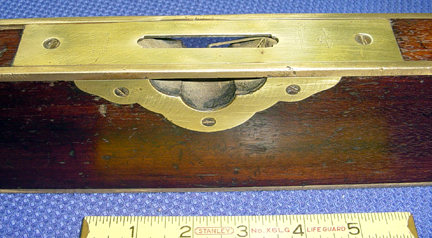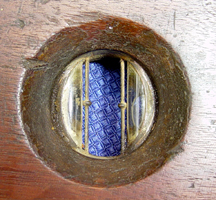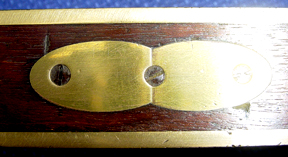A Collection of Unusual Finds
Unusual Stratton Brothers No. 1 Level
One of the more pleasant aspect of searching for tools is to go
to a local auction--one not frequented by tool-knowledgeable folks--and find
something so different as to be worthy of outbidding even the antiques buffs
looking for something shiny to put in their shops. This kind of event
happened to me this week.
When I previewed a local auction that seldom has good tools,
but often has other interesting things, it was apparent that a fancier of levels
had some things that were offered to the auction. There were four large
carpenter's levels at the preview. Three of these were bunched in the same
lot (along with a derelict claw hammer), and placed outside for the early
auction. The first was a beaten up, painted, and rotten Mulliken &
Stackpole of no account. The other two included a quite decent Stanley 02
and a very nice H.M. Pool Cuban mahogany level. Inside, featured on the
front table, was a bright and shiny brass-bound Stratton Brothers No. 1 mahogany
level that certainly grabbed the eye of everyone who entered the auction hall.

 The
level had some faults that certainly reduced its value. It was over
cleaned, with brass buffed to a high polish. There was an old hang hole
drilled near one end, and a couple of dings in the very dense mahogany (that
looked at first like rosewood). But the level was properly marked, "No. 1"
on one brass end plate, and with its 3 patent dates was an example of the late,
type 5, level as made about 1902 or so. To its credit all of the vials
were good and original.
The
level had some faults that certainly reduced its value. It was over
cleaned, with brass buffed to a high polish. There was an old hang hole
drilled near one end, and a couple of dings in the very dense mahogany (that
looked at first like rosewood). But the level was properly marked, "No. 1"
on one brass end plate, and with its 3 patent dates was an example of the late,
type 5, level as made about 1902 or so. To its credit all of the vials
were good and original.
 But
there was something else about the level that didn't hit me right away.
After looking at it from across the room I realized that the top cover of the
plumb vial was not the usual elliptical one, but seemed from afar to be much
fancier than normal. A closer look showed why. The plumb vial
port hole contained two plumb vials--not the usual one. These were
positioned facing each other, with the proper beaded brass wire protecting each.
And the "ornate" appearance of the vial cover stemmed from the fact that each
vial was covered (top and bottom) by its own elliptical cover.
But
there was something else about the level that didn't hit me right away.
After looking at it from across the room I realized that the top cover of the
plumb vial was not the usual elliptical one, but seemed from afar to be much
fancier than normal. A closer look showed why. The plumb vial
port hole contained two plumb vials--not the usual one. These were
positioned facing each other, with the proper beaded brass wire protecting each.
And the "ornate" appearance of the vial cover stemmed from the fact that each
vial was covered (top and bottom) by its own elliptical cover.
But their lengths required that each was cut short, and then
the cut ends were  butted
together to form kind of a "butterfly" figure above and below the vials on the
bottom and top of the level. The combined covers are held with 3
screws--one on each end and one in the middle, that one fixing both covers.
The appearance of the piece suggested that this was a factory-made
arrangement--not a user afterthought.
butted
together to form kind of a "butterfly" figure above and below the vials on the
bottom and top of the level. The combined covers are held with 3
screws--one on each end and one in the middle, that one fixing both covers.
The appearance of the piece suggested that this was a factory-made
arrangement--not a user afterthought.
At the moment this struck me as a feature that I'd never
noticed in a Stratton Brothers level, and caused me to enter the spirited
bidding among the brass-struck antique dealers and an anonymous absentee bidder.
My bidding prevailed.
Back at home I could not find an example of a Stratton Brothers
level with double plumb vials in the same port hole, nor is the feature
mentioned in Don Rosebrook's level book. The efficacy of having two plumb
vials facing each other is understandable given that Stratton Brothers used
arched vials in their levels. A single plumb vial restricts its use to the
"up" position, where the bottom of the level, registered against a vertical
surface must have the port hole at the above the center of the level. With
two vials, the level can be positioned differently so the port hole can be
viewed whether the level is held high or low. Moreover, having two vials allows
for an instant check of "plumbness". The level can simply be flipped
against a true vertical surface to make sure the level is adjusted properly.
These advantages suggest that this level may have been some sort of
experimental, prototype, or special level made to explore these (and perhaps
other advantages.)


 The
level had some faults that certainly reduced its value. It was over
cleaned, with brass buffed to a high polish. There was an old hang hole
drilled near one end, and a couple of dings in the very dense mahogany (that
looked at first like rosewood). But the level was properly marked, "No. 1"
on one brass end plate, and with its 3 patent dates was an example of the late,
type 5, level as made about 1902 or so. To its credit all of the vials
were good and original.
The
level had some faults that certainly reduced its value. It was over
cleaned, with brass buffed to a high polish. There was an old hang hole
drilled near one end, and a couple of dings in the very dense mahogany (that
looked at first like rosewood). But the level was properly marked, "No. 1"
on one brass end plate, and with its 3 patent dates was an example of the late,
type 5, level as made about 1902 or so. To its credit all of the vials
were good and original. But
there was something else about the level that didn't hit me right away.
After looking at it from across the room I realized that the top cover of the
plumb vial was not the usual elliptical one, but seemed from afar to be much
fancier than normal. A closer look showed why. The plumb vial
port hole contained two plumb vials--not the usual one. These were
positioned facing each other, with the proper beaded brass wire protecting each.
And the "ornate" appearance of the vial cover stemmed from the fact that each
vial was covered (top and bottom) by its own elliptical cover.
But
there was something else about the level that didn't hit me right away.
After looking at it from across the room I realized that the top cover of the
plumb vial was not the usual elliptical one, but seemed from afar to be much
fancier than normal. A closer look showed why. The plumb vial
port hole contained two plumb vials--not the usual one. These were
positioned facing each other, with the proper beaded brass wire protecting each.
And the "ornate" appearance of the vial cover stemmed from the fact that each
vial was covered (top and bottom) by its own elliptical cover.  butted
together to form kind of a "butterfly" figure above and below the vials on the
bottom and top of the level. The combined covers are held with 3
screws--one on each end and one in the middle, that one fixing both covers.
The appearance of the piece suggested that this was a factory-made
arrangement--not a user afterthought.
butted
together to form kind of a "butterfly" figure above and below the vials on the
bottom and top of the level. The combined covers are held with 3
screws--one on each end and one in the middle, that one fixing both covers.
The appearance of the piece suggested that this was a factory-made
arrangement--not a user afterthought.